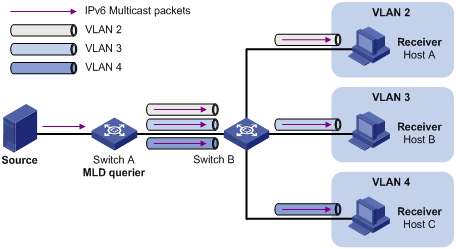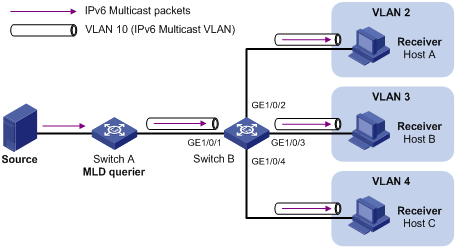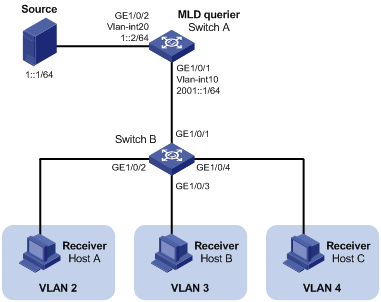- Table of Contents
-
- 06-IP Multicast Configuration Guide
- 00-Preface
- 01-Multicast overview
- 02-IGMP snooping configuration
- 03-PIM snooping configuration
- 04-Multicast VLAN configuration
- 05-Multicast routing and forwarding configuration
- 06-IGMP configuration
- 07-PIM configuration
- 08-MSDP configuration
- 09-MLD snooping configuration
- 10-IPv6 PIM snooping configuration
- 11-IPv6 multicast VLAN configuration
- 12-IPv6 multicast routing and forwarding configuration
- 13-MLD configuration
- 14-IPv6 PIM configuration
- Related Documents
-
| Title | Size | Download |
|---|---|---|
| 11-IPv6 multicast VLAN configuration | 138.47 KB |
Configuring IPv6 multicast VLANs
IPv6 multicast VLAN configuration task list
Configuring a sub-VLAN-based IPv6 multicast VLAN
Configuration restrictions and guidelines
Configuring a port-based IPv6 multicast VLAN
Configuring user port attributes
Assigning user ports to an IPv6 multicast VLAN
Setting the maximum number of IPv6 multicast VLAN forwarding entries
Displaying and maintaining IPv6 multicast VLANs
IPv6 multicast VLAN configuration examples
Sub-VLAN-based IPv6 multicast VLAN configuration example
Port-based IPv6 multicast VLAN configuration example
Configuring IPv6 multicast VLANs
Overview
As shown in Figure 1, Host A, Host B, and Host C are in different VLANs and the same IPv6 multicast group. When Switch A (Layer 3 device) receives IPv6 multicast data for that group, it forwards three copies of the data to Switch B (Layer 2 device). This occupies a large amount of bandwidth and increases the burden on the Layer 3 device.
Figure 1 Multicast transmission without the IPv6 multicast VLAN feature

After an IPv6 multicast VLAN is configured on Switch B, Switch A sends one copy of the IPv6 multicast data to the IPv6 multicast VLAN on Switch B. This saves network bandwidth and lessens the burden on the Layer 3 device.
IPv6 multicast VLANs include sub-VLAN-based IPv6 multicast VLANs and port-based IPv6 multicast VLANs.
Sub-VLAN-based IPv6 multicast VLAN
As shown in Figure 2:
· Host A, Host B, and Host C are in VLAN 2 through VLAN 4, respectively.
· On Switch B, VLAN 10 is an IPv6 multicast VLAN. VLAN 2 through VLAN 4 are sub-VLANs of VLAN 10.
· MLD snooping is enabled for the multicast VLAN and its sub-VLANs.
Figure 2 Sub-VLAN-based multicast VLAN

MLD snooping manages router ports in the IPv6 multicast VLAN and member ports in each sub-VLAN. When Switch A receives IPv6 multicast data from the IPv6 multicast source, it sends only one copy of the IPv6 multicast data to the IPv6 multicast VLAN on Switch B. Then, Switch B sends a separate copy to each sub-VLAN of the IPv6 multicast VLAN.
Port-based IPv6 multicast VLAN
As shown in Figure 3:
· Host A, Host B, and Host C are in VLAN 2 through VLAN 4, respectively. All the user ports (ports with attached hosts) on Switch B are hybrid ports.
· On Switch B, VLAN 10 is an IPv6 multicast VLAN. All the user ports are assigned to VLAN 10.
· MLD snooping is enabled for the IPv6 multicast VLAN and its sub-VLANs.
Figure 3 Port-based IPv6 multicast VLAN

MLD snooping manages the router ports and member ports in the IPv6 multicast VLAN. When Switch A receives IPv6 multicast data from the IPv6 multicast source, it sends only one copy of the IPv6 multicast data to the IPv6 multicast VLAN on Switch B. Then, Switch B sends a separate copy to each user port in the IPv6 multicast VLAN.
IPv6 multicast VLAN configuration task list
|
Tasks at a glance |
|
(Required.) Perform one of the following tasks: · Configuring a sub-VLAN-based IPv6 multicast VLAN · Configuring a port-based IPv6 multicast VLAN: |
|
(Optional.) Setting the maximum number of IPv6 multicast VLAN forwarding entries |
When you configure the IPv6 multicast VLANs, follow these guidelines:
· If you have configured both a sub-VLAN-based IPv6 multicast VLAN and a port-based IPv6 multicast VLAN on a device, the port-based IPv6 multicast VLAN configuration takes effect.
· The IPv6 multicast VLAN feature does not take effect on secondary VLANs. As a best practice, do not configure the IPv6 multicast VLAN feature for secondary VLANs. For more information about secondary VLAN, see Layer 2—LAN Switching Configuration Guide.
Configuring a sub-VLAN-based IPv6 multicast VLAN
To configure a sub-VLAN-based IPv6 multicast VLAN, configure a VLAN as an IPv6 multicast VLAN, and assign the VLANs that contain multicast receivers to the IPv6 multicast VLAN as sub-VLANs.
Configuration prerequisites
Before you configure a sub-VLAN-based IPv6 multicast VLAN, complete the following tasks:
· Create VLANs as required.
Configuration restrictions and guidelines
When you configure a sub-VLAN-based IPv6 multicast VLAN, follow these restrictions and guidelines:
· The VLAN to be configured as the IPv6 multicast VLAN must exist.
· A VLAN to be configured as a sub-VLAN must exist and cannot be an IPv6 multicast VLAN or a sub-VLAN of any other IPv6 multicast VLANs.
· The total number of IPv6 multicast VLANs on a device cannot exceed the upper limit.
· Make sure no trunk port exists both in an IPv6 multicast VLAN and a sub-VLAN of the IPv6 multicast VLAN.
Configuration procedure
To configure a sub-VLAN-based IPv6 multicast VLAN:
|
Step |
Command |
Remarks |
|
1. Enter system view. |
system-view |
N/A |
|
2. Configure a VLAN as an IPv6 multicast VLAN and enter its view. |
ipv6 multicast-vlan vlan-id |
By default, a VLAN is not an IPv6 multicast VLAN. |
|
3. Assign the specified VLANs to the IPv6 multicast VLAN as sub-VLANs. |
subvlan vlan-list |
By default, an IPv6 multicast VLAN does not have any sub-VLANs. |
Configuring a port-based IPv6 multicast VLAN
You can assign only Layer 2 Ethernet interfaces or Layer 2 aggregate interfaces as user ports to an IPv6 multicast VLAN.
Configuration prerequisites
Before you configure a port-based IPv6 multicast VLAN, complete the following tasks:
· Create VLANs as required.
· Enable MLD snooping for the VLAN to be configured as the IPv6 multicast VLAN.
· Enable MLD snooping for all the VLANs that contain the multicast receivers.
Configuring user port attributes
|
Step |
Command |
Remarks |
|
1. Enter system view. |
system-view |
N/A |
|
2. Enter interface view. |
interface interface-type interface-number |
N/A |
|
3. Configure the link type of the user port as hybrid. |
port link-type hybrid |
The default setting is access. For more information about this command, see Layer 2—LAN Switching Command Reference. |
|
4. Specify the PVID of the current user port as the VLAN to which the user port belongs. |
port hybrid pvid vlan vlan-id |
By default, the PVID for a hybrid port is VLAN 1. For more information about this command, see Layer 2—LAN Switching Command Reference. |
|
5. Configure the current user port to permit IPv6 multicast VLAN and to untag the packets. |
port hybrid vlan vlan-id-list untagged |
By default, a hybrid port permits only VLAN 1. For more information about this command, see Layer 2—LAN Switching Command Reference. |
Assigning user ports to an IPv6 multicast VLAN
You can assign user ports to an IPv6 multicast VLAN in IPv6 multicast VLAN view or assign a user port to an IPv6 multicast VLAN in interface view.
Configuration restrictions and guidelines
When you perform this task, follow these restrictions and guidelines:
· The VLAN to be configured as an IPv6 multicast VLAN must exist.
· A port can belong to only one IPv6 multicast VLAN.
Configuration procedure
To assign user ports to an IPv6 multicast VLAN in IPv6 multicast VLAN view:
|
Step |
Command |
Remarks |
|
1. Enter system view. |
system-view |
N/A |
|
2. Configure an IPv6 VLAN as an IPv6 multicast VLAN and enter its view. |
ipv6 multicast-vlan vlan-id |
By default, a VLAN is not an IPv6 multicast VLAN. |
|
3. Assign ports to the IPv6 multicast VLAN. |
port interface-list |
By default, an IPv6 multicast VLAN does not have any user ports. |
To assign a user port to an IPv6 multicast VLAN in interface view:
|
Step |
Command |
Remarks |
|
1. Enter system view. |
system-view |
N/A |
|
2. Configure an IPv6 VLAN as an IPv6 multicast VLAN and enter its view. |
ipv6 multicast-vlan vlan-id |
By default, a VLAN is not an IPv6 multicast VLAN. |
|
3. Return to system view. |
quit |
N/A |
|
4. Enter interface view. |
interface interface-type interface-number |
N/A |
|
5. Assign the current port to the IPv6 multicast VLAN. |
ipv6 port multicast-vlan vlan-id |
By default, a user port does not belong to any IPv6 multicast VLAN. |
Setting the maximum number of IPv6 multicast VLAN forwarding entries
You can set the maximum number of IPv6 multicast VLAN forwarding entries on the device. When the upper limit is reached, the device does not create IPv6 multicast VLAN forwarding entries until some entries age out or are manually removed.
If the total number of entries exceeds the upper limit value that you are setting, the system does not automatically remove existing entries or create new entries. In this case, remove excessive entries manually.
To set the maximum number of IPv6 multicast VLAN forwarding entries:
|
Step |
Command |
Remarks |
|
1. Enter system view. |
system-view |
N/A |
|
2. Set the maximum number of IPv6 multicast VLAN forwarding entries. |
ipv6 multicast-vlan entry-limit limit |
By default, the maximum number of IPv6 multicast VLAN forwarding entries is 2000. |
Displaying and maintaining IPv6 multicast VLANs
Execute display commands in any view and reset commands in user view.
|
Command |
|
|
Display information about IPv6 multicast VLANs. |
display ipv6 multicast-vlan [ vlan-id ] |
|
Display information about information about IPv6 multicast group entries in IPv6 multicast VLANs. |
display ipv6 multicast-vlan group [ ipv6-source-address | ipv6-group-address | slot slot-number | verbose | vlan vlan-id ] * |
|
Display IPv6 multicast VLAN forwarding entries. |
display ipv6 multicast-vlan forwarding-table [ ipv6-source-address [ prefix-length ] | ipv6-group-address [ prefix-length ] | slot slot-number | subvlan vlan-id | vlan vlan-id ] * |
|
Clear IPv6 multicast group entries in IPv6 multicast VLANs. |
reset ipv6 multicast-vlan group [ ipv6-group-address [ prefix-length ] | ipv6-source-address [ prefix-length ] | vlan vlan-id ] * |
IPv6 multicast VLAN configuration examples
Sub-VLAN-based IPv6 multicast VLAN configuration example
Network requirements
As shown in Figure 4:
· Layer 3 device Switch A runs MLD and acts as the MLD querier. Layer 2 device Switch B runs MLDv1 snooping.
· The IPv6 multicast source sends IPv6 multicast data to IPv6 multicast group FF1E::101. Receivers Host A, Host B, and Host C belong to VLAN 2, VLAN 3, and VLAN 4, respectively.
Configure a sub-VLAN-based IPv6 multicast VLAN on Switch B to meet the following requirements:
· Switch A sends the IPv6 multicast data to Switch B through the IPv6 multicast VLAN.
· Switch B forwards the IPv6 multicast data to the receivers in different user VLANs.

Configuration procedure
1. Configure Switch A:
# Enable IPv6 multicast routing.
<SwitchA> system-view
[SwitchA] ipv6 multicast routing
[SwitchA-mrib6] quit
# Create VLAN 20, and assign GigabitEthernet 1/0/2 to the VLAN.
[SwitchA] vlan 20
[SwitchA-vlan20] port gigabitethernet 1/0/2
[SwitchA-vlan20] quit
# Assign an IPv6 address to VLAN-interface 20, and enable IPv6 PIM-DM on the interface.
[SwitchA] interface vlan-interface 20
[SwitchA-Vlan-interface20] ipv6 address 1::2 64
[SwitchA-Vlan-interface20] ipv6 pim dm
[SwitchA-Vlan-interface20] quit
# Create VLAN 10.
[SwitchA] vlan 10
[SwitchA-vlan10] quit
# Configure GigabitEthernet 1/0/1 as a hybrid port, and assign the port to VLAN 10 as a tagged VLAN member.
[SwitchA] interface gigabitethernet 1/0/1
[SwitchA-GigabitEthernet1/0/1] port link-type hybrid
[SwitchA-GigabitEthernet1/0/1] port hybrid vlan 10 tagged
[SwitchA-GigabitEthernet1/0/1] quit
# Assign an IPv6 address to VLAN-interface 10, and enable MLD on the interface.
[SwitchA] interface vlan-interface 10
[SwitchA-Vlan-interface10] ipv6 address 2001::1 64
[SwitchA-Vlan-interface10] mld enable
[SwitchA-Vlan-interface10] quit
2. Configure Switch B:
# Enable the MLD snooping feature.
<SwitchB> system-view
[SwitchB] mld-snooping
[SwitchB-mld-snooping] quit
# Create VLAN 2, assign GigabitEthernet 1/0/2 to the VLAN, and enable MLD snooping for the VLAN.
[SwitchB] vlan 2
[SwitchB-vlan2] port gigabitethernet 1/0/2
[SwitchB-vlan2] mld-snooping enable
[SwitchB-vlan2] quit
# Create VLAN 3, assign GigabitEthernet 1/0/3 to the VLAN, and enable MLD snooping for the VLAN.
[SwitchB] vlan 3
[SwitchB-vlan3] port gigabitethernet 1/0/3
[SwitchB-vlan3] mld-snooping enable
[SwitchB-vlan3] quit
# Create VLAN 4, assign GigabitEthernet 1/0/4 to the VLAN, and enable MLD snooping for the VLAN.
[SwitchB] vlan 4
[SwitchB-vlan4] port gigabitethernet 1/0/4
[SwitchB-vlan4] mld-snooping enable
[SwitchB-vlan4] quit
# Create VLAN 10, and enable MLD snooping for the VLAN.
[SwitchB] vlan 10
[SwitchB-vlan10] mld-snooping enable
[SwitchB-vlan10] quit
# Configure GigabitEthernet 1/0/1 as a hybrid port, and assign the port to VLAN 10 as a tagged VLAN member.
[SwitchB] interface gigabitethernet 1/0/1
[SwitchB-GigabitEthernet1/0/1] port link-type hybrid
[SwitchB-GigabitEthernet1/0/1] port hybrid vlan 10 tagged
[SwitchB-GigabitEthernet1/0/1] quit
# Configure VLAN 10 as an IPv6 multicast VLAN, and assign VLAN 2 through VLAN 4 as sub-VLANs to multicast VLAN 10.
[SwitchB] ipv6 multicast-vlan 10
[SwitchB-ipv6-mvlan-10] subvlan 2 to 4
[SwitchB-ipv6-mvlan-10] quit
Verifying the configuration
# Display information about all IPv6 multicast VLANs on Switch B.
[SwitchB] display ipv6 multicast-vlan
Total 1 IPv6 multicast VLANs.
IPv6 multicast VLAN 10:
Sub-VLAN list(3 in total):
2-4
Port list(0 in total):
# Display information about IPv6 multicast groups in IPv6 multicast VLANs on Switch B.
[SwitchB] display ipv6 multicast-vlan group
Total 1 entries.
IPv6 multicast VLAN 10: Total 1 entries.
(::, FF1E::101)
Sub-VLANs (3 in total):
VLAN 2
VLAN 3
VLAN 4
The output shows that IPv6 multicast group FF1E::101 belongs to IPv6 multicast VLAN 10. IPv6 multicast VLAN 10 contains sub-VLANs VLAN 2 through VLAN 4. Switch B will replicate the IPv6 multicast data of VLAN 10 to VLAN 2 through VLAN 4.
Port-based IPv6 multicast VLAN configuration example
Network requirements
As shown in Figure 5:
· Layer 3 device Switch A runs MLDv1 and acts as the MLD querier. Layer 2 device Switch B runs MLDv1 snooping.
· The IPv6 multicast source sends IPv6 multicast data to IPv6 multicast group FF1E::101. Receivers Host A, Host B, and Host C belong to VLAN 2, VLAN 3, and VLAN 4, respectively.
Configure a port-based IPv6 multicast VLAN on Switch B to meet the following requirements:
· Switch A sends IPv6 multicast data to Switch B through the IPv6 multicast VLAN.
· Switch B forwards the IPv6 multicast data to the receivers in different user VLANs.

Configuration procedure
1. Configure Switch A:
# Enable IPv6 multicast routing.
<SwitchA> system-view
[SwitchA] ipv6 multicast routing
[SwitchA-mrib6] quit
# Create VLAN 20, and assign GigabitEthernet 1/0/2 to the VLAN.
[SwitchA] vlan 20
[SwitchA-vlan20] port gigabitethernet 1/0/2
[SwitchA-vlan20] quit
# Assign an IPv6 address to VLAN-interface 20, and enable IPv6 PIM-DM on the interface.
[SwitchA] interface vlan-interface 20
[SwitchA-Vlan-interface20] ipv6 address 1::2 64
[SwitchA-Vlan-interface20] ipv6 pim dm
[SwitchA-Vlan-interface20] quit
# Create VLAN 10, and assign GigabitEthernet 1/0/1 to the VLAN.
[SwitchA] vlan 10
[SwitchA-vlan10] port gigabitethernet 1/0/1
[SwitchA-vlan10] quit
# Assign an IPv6 address to VLAN-interface 10, and enable MLD on the interface.
[SwitchA] interface vlan-interface 10
[SwitchA-Vlan-interface10] ipv6 address 2001::1 64
[SwitchA-Vlan-interface10] mld enable
[SwitchA-Vlan-interface10] quit
2. Configure Switch B:
# Enable the MLD snooping feature.
<SwitchB> system-view
[SwitchB] mld-snooping
[SwitchB-mld-snooping] quit
# Create VLAN 10, assign GigabitEthernet 1/0/1 to the VLAN, and enable MLD snooping for the VLAN.
[SwitchB] vlan 10
[SwitchB-vlan10] port gigabitethernet 1/0/1
[SwitchB-vlan10] mld-snooping enable
[SwitchB-vlan10] quit
# Create VLAN 2, and enable MLD snooping for the VLAN.
[SwitchB] vlan 2
[SwitchB-vlan2] mld-snooping enable
[SwitchB-vlan2] quit
# Create VLAN 3, and enable MLD snooping for the VLAN.
[SwitchB] vlan 3
[SwitchB-vlan3] mld-snooping enable
[SwitchB-vlan3] quit
# Create VLAN 4, and enable MLD snooping for the VLAN.
[SwitchB] vlan 4
[SwitchB-vlan4] mld-snooping enable
[SwitchB-vlan4] quit
# Configure GigabitEthernet 1/0/2 as a hybrid port, and configure VLAN 2 as the PVID of the hybrid port.
[SwitchB] interface gigabitethernet 1/0/2
[SwitchB-GigabitEthernet1/0/2] port link-type hybrid
[SwitchB-GigabitEthernet1/0/2] port hybrid pvid vlan 2
# Assign GigabitEthernet 1/0/2 to VLAN 2 and VLAN 10 as an untagged VLAN member.
[SwitchB-GigabitEthernet1/0/2] port hybrid vlan 2 untagged
[SwitchB-GigabitEthernet1/0/2] port hybrid vlan 10 untagged
[SwitchB-GigabitEthernet1/0/2] quit
# Configure GigabitEthernet 1/0/3 as a hybrid port, and configure VLAN 3 as the PVID of the hybrid port.
[SwitchB] interface gigabitethernet 1/0/3
[SwitchB-GigabitEthernet1/0/3] port link-type hybrid
[SwitchB-GigabitEthernet1/0/3] port hybrid pvid vlan 3
# Assign GigabitEthernet 1/0/3 to VLAN 3 and VLAN 10 as an untagged VLAN member.
[SwitchB-GigabitEthernet1/0/3] port hybrid vlan 3 untagged
[SwitchB-GigabitEthernet1/0/3] port hybrid vlan 10 untagged
[SwitchB-GigabitEthernet1/0/3] quit
# Configure GigabitEthernet 1/0/4 as a hybrid port, and configure VLAN 4 as the PVID of the hybrid port.
[SwitchB] interface gigabitethernet 1/0/4
[SwitchB-GigabitEthernet1/0/4] port link-type hybrid
[SwitchB-GigabitEthernet1/0/4] port hybrid pvid vlan 4
# Assign GigabitEthernet 1/0/4 to VLAN 4 and VLAN 10 as an untagged VLAN member.
[SwitchB-GigabitEthernet1/0/4] port hybrid vlan 4 untagged
[SwitchB-GigabitEthernet1/0/4] port hybrid vlan 10 untagged
[SwitchB-GigabitEthernet1/0/4] quit
# Configure VLAN 10 as an IPv6 multicast VLAN.
[SwitchB] ipv6 multicast-vlan 10
# Assign GigabitEthernet 1/0/2 and GigabitEthernet 1/0/3 to VLAN 10.
[SwitchB-ipv6-mvlan-10] port gigabitethernet 1/0/2 to gigabitethernet 1/0/3
[SwitchB-ipv6-mvlan-10] quit
# Assign GigabitEthernet 1/0/4 to VLAN 10.
[SwitchB] interface gigabitethernet 1/0/4
[SwitchB-GigabitEthernet1/0/4] ipv6 port multicast-vlan 10
[SwitchB-GigabitEthernet1/0/4] quit
Verifying the configuration
# Display information about IPv6 multicast VLANs on Switch B.
[SwitchB] display ipv6 multicast-vlan
Total 1 IPv6 multicast VLANs.
IPv6 multicast VLAN 10:
Sub-VLAN list(0 in total):
Port list(0 in total):
GE1/0/2
GE1/0/3
GE1/0/4
# Display dynamic MLD snooping forwarding entries on Switch B.
[SwitchB] display mld-snooping group
Total 1 entries.
VLAN 10: Total 1 entries.
(::, FF1E::101)
Host slots (0 in total):
Host ports (3 in total):
GE1/0/2 (00:03:23)
GE1/0/3 (00:04:07)
GE1/0/4 (00:04:16)
The output shows that MLD snooping maintains the user ports in the multicast VLAN (VLAN 10). Switch B will forward the IPv6 multicast data of VLAN 10 through these user ports.
